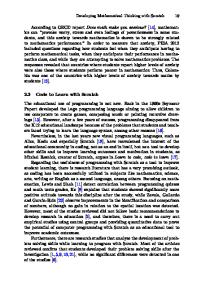Learning Tree Thinking: Developing a New Framework of Representational Competence
Phylogenetic trees are dynamic external representations used to illustrate evolutionary relatedness among taxa. However, students often struggle with correctly interpreting and using these representations in biology courses. In order to optimize learning,
- PDF / 255,981 Bytes
- 17 Pages / 439.37 x 666.142 pts Page_size
- 28 Downloads / 375 Views
Learning Tree Thinking: Developing a New Framework of Representational Competence Kristy L. Halverson and Patricia Friedrichsen
Introduction A major goal of science education is to develop scientific literacy (National Research Council, 1996; Rutherford & Ahlgren, 1990). One component of scientific literacy is the ability to use common representations of phenomena, such as molecular models (Ferk, Vrtacnik, Blejec, & Gril, 2003), abstract physics diagrams (Chi, Feltovich, & Glaser, 1981), Punnett squares (Cavallo, 1996), and genetic molecules—such as DNA diagrams (Patrick, Carter, & Wiebe, 2005; Takayama, 2005), pedigrees (Hackling & Lawrence, 1988), and phylogenetic trees (Matuk, 2007). Representations affect multiple aspects of learning including the following: reasoning through problems and phenomena, developing deeper understandings of the relationships among phenomena, and improving creativity (Peterson, 1994). We use representations to explain how we make sense of things on a daily basis and are critical for communicating abstract science concepts (Gilbert, 2005a). In science, visual representations are used to display data, organize complex information, and promote a shared understanding of scientific phenomena (Kozma & Russell, 2005; Roth, Bowen, & McGinn, 1999). Researchers are interested in investigating how visual representations affect content understanding and how students evaluate and interact with visual representations (Ferk et al., 2003). More specifically, visual representations enhance learning from texts, improve problem solving, and facilitate developing connections between new knowledge and prior knowledge (Cook, 2006; Roth et al., 1999).
K.L. Halverson (*) Department of Biological Sciences, University of Southern Mississippi, Hattiesburg, MS, USA e-mail: [email protected] P. Friedrichsen Division of Biological Sciences, Department of Learning, Teaching and Curriculum, University of Missouri, Columbia, MO, USA e-mail: [email protected] D.F. Treagust and C.-Y. Tsui (eds.), Multiple Representations in Biological Education, Models and Modeling in Science Education 7, DOI 10.1007/978-94-007-4192-8_11, # Springer Science+Business Media B.V. 2013
185
186
K.L. Halverson and P. Friedrichsen
Studies highlight the importance of both content knowledge mastery as well as spatial reasoning (Bodner & Guay, 1997; Halverson, 2010; Maroo & Halverson, 2011). Researchers also agree that students have difficulties understanding and interacting with representations (e.g., Ainsworth, 2008; Anderson & Leinhardt, 2002; Ferk et al., 2003; Reiss & Tunnicliffe, 2001; Tufte, 2001; Zbiek, Heid, Blume, & Dick, 2007). Student difficulties include the following: identifying key structures of representations, interpreting and using representations, transitioning among different modes of representations, and relating abstract representations to content knowledge. However, abilities such as transitioning between different modes of representations (e.g., 2-D and 3-D models) are a vital part of becoming an e
Data Loading...











